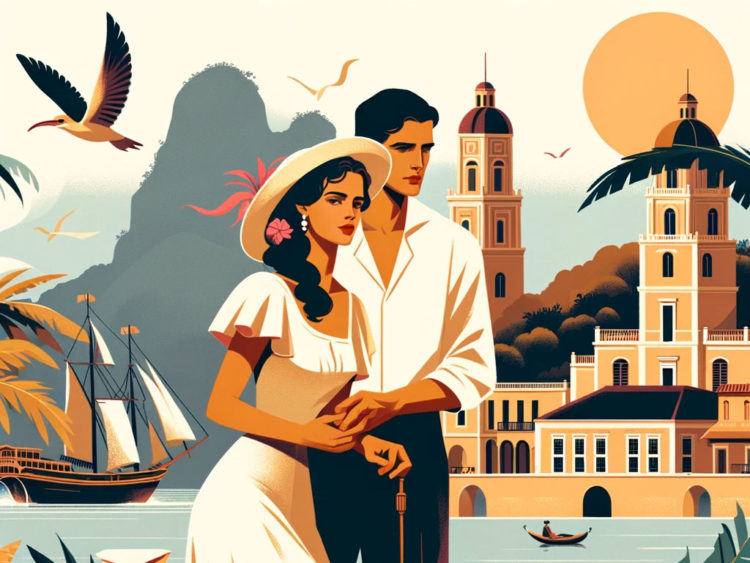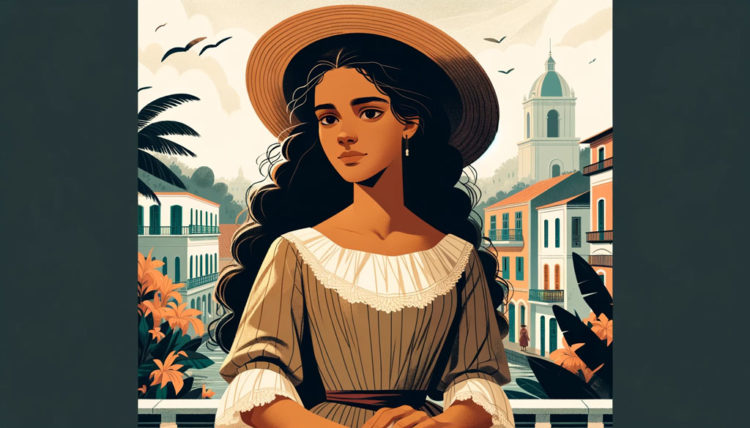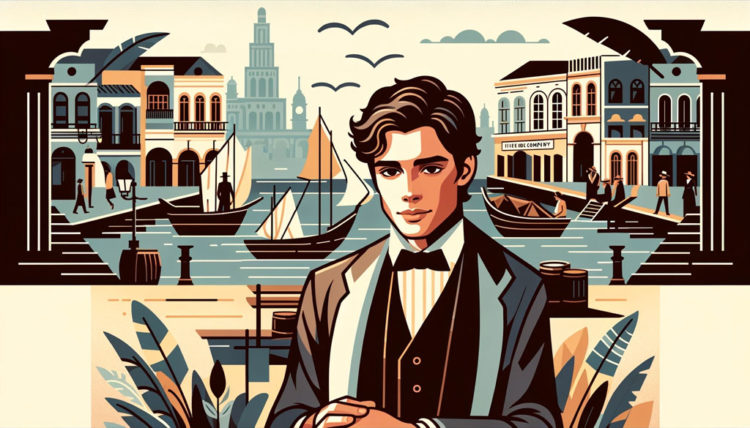“Love in the Time of Cholera” explores the enduring power of love through the story of Florentino Ariza and Fermina Daza, who fall in love in their youth and reunite in their old age. It’s a profound meditation on the nature of love and aging by Gabriel García Márquez. Looking for a summary, complete synopsis, characters breakdown? I got you covered.
Short Recap
“Love in the Time of Cholera” revolves around a decades-long, unrequited love story between Florentino Ariza and Fermina Daza. In their youth in the Caribbean port city, Florentino falls passionately in love with Fermina. However, Fermina eventually marries Dr. Juvenal Urbino, a wealthy and well-regarded doctor.
The novel spans over 50 years, during which Florentino holds onto his love for Fermina, despite her marriage and his numerous romantic affairs with other women. Dr. Urbino proves to be a faithful husband, and he and Fermina share a life together, though it’s not without its challenges. The story also explores themes of love in various forms, from romantic to platonic, and the societal norms and expectations surrounding relationships.
After Dr. Urbino’s death, Florentino, now an old man, redeclares his love for Fermina. Initially shocked and angry, Fermina eventually gives in to her own feelings. The novel ends with the elderly lovers taking a riverboat trip together, with Florentino ordering the captain to sail the boat back and forth indefinitely, symbolizing the timeless and enduring nature of their love, finally fulfilled in their old age.
Comprehensive Plot Summary of “Love in the Time of Cholera”
Chapter 1: “Dr. Urbino’s Death and Florentino’s Declaration”
The novel opens with the death of Dr. Juvenal Urbino, a distinguished doctor in the Caribbean city where the story is set. His death is accidental, resulting from a fall while trying to catch his pet parrot. The chapter introduces Dr. Urbino as a highly respected figure who played a key role in eradicating cholera in the city. The narrative then shifts to a brief history of Dr. Urbino’s marriage to Fermina Daza, a union that began with a passionate courtship but settled into a comfortable, if somewhat routine, companionship over the years. Concurrently, the chapter reintroduces Florentino Ariza, who has silently loved Fermina for over fifty years since their youthful romance ended. At Dr. Urbino’s wake, Florentino finally declares his enduring love to Fermina, reigniting the central conflict of the novel.
Chapter 2: “The Youthful Romance of Fermina and Florentino”
Chapter 2 delves into the backstory of Fermina Daza and Florentino Ariza’s youthful romance. It describes how Fermina, while still a schoolgirl, attracts the intense, romantic attention of Florentino, a young telegraph operator. Their courtship is carried out through secret letters and fleeting glances, developing into a deep, albeit hidden, romance. However, Fermina’s father, Lorenzo Daza, disapproves of the relationship due to Florentino’s lower social status. After discovering their secret correspondence, Lorenzo takes Fermina on a long journey to forget Florentino. Upon their return, Fermina abruptly rejects Florentino, realizing that what she felt was more the illusion of love than love itself.
Chapter 3: “Dr. Urbino’s Life and Marriage to Fermina”
The third chapter focuses on the life and character of Dr. Juvenal Urbino. It explores his efforts to modernize both his city and the field of medicine, influenced by his education in Paris. The chapter also recounts how Dr. Urbino met Fermina Daza and how their relationship, initially based on social suitability and intellectual compatibility, grew into love and marriage. This chapter sets a contrast between the passionate, yet ultimately unfulfilled, love of Florentino for Fermina and the more pragmatic, socially appropriate relationship she develops with Dr. Urbino. The chapter ends with a deeper understanding of the Urbino-Daza marriage, providing insight into their domestic life and Dr. Urbino’s progressive, yet sometimes rigid, views on society and morality.
Chapter 4: “Fermina’s Married Life and Florentino’s Affairs”
This chapter delves into Fermina’s life with Dr. Urbino, showcasing their stable but emotionally reserved marriage. It contrasts this with Florentino’s life, where he engages in various affairs, though he remains emotionally faithful to Fermina. His career at the River Company of the Caribbean flourishes, and he uses his position to satisfy his romantic escapades. Despite his many liaisons, Florentino’s heart remains with Fermina, reflecting his undying devotion.
Chapter 5: “Florentino’s Ascendancy and Urbino’s Later Years”
Florentino’s rise in the River Company and his continued amorous adventures are highlighted in this chapter. Simultaneously, Dr. Urbino’s later years are depicted, showing his and Fermina’s adaptation to modern life and their struggles with aging. The chapter gives insight into the changing dynamics of the Urbino household and Florentino’s persistent yearning for Fermina amidst his own aging and professional successes.
Chapter 6: “Reunion and the Journey on the River”
Following Dr. Urbino’s death, Florentino renews his pursuit of Fermina. Initially, Fermina is resistant, but gradually, she reciprocates his affections, leading to a late-in-life romance. The chapter culminates with Fermina and Florentino embarking on a river journey aboard a boat owned by Florentino’s company. As they sail, Florentino orders the captain to keep the boat traveling indefinitely, symbolizing their timeless love. This final chapter poignantly captures their ultimate reunion and the fulfillment of a love that endured the vicissitudes of time.
Main Characters Breakdown
Fermina Daza
- Personality: Independent, strong-willed, and practical.
- Age: Her story spans from adolescence to old age.
- Gender: Female
- Role: The primary female protagonist, object of Florentino Ariza’s lifelong affection.
- Arc: From a rebellious teenager in love with Florentino to a mature woman married to Dr. Urbino, her journey reflects the complexities of love, societal expectations, and personal growth.
- Notable Aspects: Her decision to marry Dr. Urbino over Florentino and her evolving understanding of love and companionship form the heart of the novel.
Florentino Ariza
- Personality: Romantic, obsessive, and enduring.
- Age: His story also covers his life from youth to old age.
- Gender: Male
- Role: The male protagonist, hopelessly in love with Fermina Daza.
- Arc: From a young, passionate lover to an old man who finally wins Fermina’s love, his life is a testament to unyielding love and obsession.
- Notable Aspects: His numerous affairs and his unswerving devotion to Fermina, even in her absence, define his life.
Dr. Juvenal Urbino
- Personality: Dignified, progressive, and often rigid.
- Age: His story is told from his early adulthood to his death.
- Gender: Male
- Role: Fermina’s husband, a respected doctor.
- Arc: His journey is one of striving for modernization and battling the cholera epidemic, as well as navigating the complexities of his marriage.
- Notable Aspects: His death early in the novel sets the stage for the rekindling of Fermina’s past love affair.
Lorenzo Daza
- Personality: Ambitious, socially aspirant.
- Age: Middle-aged during most of the story.
- Gender: Male
- Role: Fermina’s father, a mule driver turned merchant.
- Arc: His story is more about his social aspirations than personal development.
- Notable Aspects: His disapproval of Fermina’s relationship with Florentino and his subsequent actions to separate them are crucial to the plot.
Leona Cassiani
- Personality: Loyal, pragmatic, and supportive.
- Age: Comparable to Florentino, her story unfolds from youth to old age.
- Gender: Female
- Role: Florentino’s coworker and confidante.
- Arc: She rises from a servant to an influential figure in Florentino’s life and business.
- Notable Aspects: Her platonic relationship with Florentino and her influence in his life and business decisions are significant.
Tránsito Ariza
- Personality: Nurturing and supportive.
- Age: Elderly during most of the story.
- Gender: Female
- Role: Florentino’s mother.
- Arc: She is a constant in Florentino’s life, offering support and advice.
- Notable Aspects: Her role as a mother and confidante to Florentino shapes much of his life and decisions.
Interesting Facts About Love in the Time of Cholera
- Nobel Influence: The novel was published in 1985, three years after Gabriel García Márquez received the Nobel Prize in Literature, adding to the anticipation and reception of the book.
- Personal Inspiration: García Márquez was inspired by the love story of his own parents, which involved a secret courtship and a disapproving father, much like the novel’s protagonists.
- Literary Style: It’s a prime example of magical realism, a style where magical elements are presented in an otherwise realistic setting, a hallmark of García Márquez’s writing.
- Global Appeal: The novel has been translated into many languages, reflecting its universal themes of love, aging, and the human condition, and cementing its status in world literature.
- Film Adaptation: A film adaptation was released in 2007, starring Javier Bardem, which, while capturing the essence of the story, received mixed reviews for its interpretation of the novel’s depth and complexity.
- Critics’ Mixed Reactions: Initially, some critics were skeptical of the novel’s portrayal of romantic love, but over time, it has been increasingly appreciated for its exploration of love’s enduring nature.
- Lasting Impact: “Love in the Time of Cholera” continues to be studied and admired for its unique narrative style and deep emotional resonance, decades after its publication.
- Cultural References: The novel has influenced various cultural works, including music and other literary works, attesting to its profound impact on popular culture.
- Title’s Origin: The title “Love in the Time of Cholera” metaphorically links the symptoms of love with those of cholera, suggesting the overwhelming and all-consuming nature of love.
Frequently Asked Questions About The Novel
What is the Significance of the Novel’s Title?
The title “Love in the Time of Cholera” metaphorically connects the emotions of love with the symptoms of cholera. It suggests how love, like a disease, can be overwhelming and all-consuming, affecting individuals deeply and often irrationally. The title sets the tone for the novel’s exploration of love’s various facets and its impact on the lives of the characters.
How Does the Setting Influence the Story?
The setting, a Caribbean city in the late 19th and early 20th centuries, significantly influences the story. It provides a backdrop that reflects the societal norms, class distinctions, and cultural attitudes of the time, particularly regarding love, marriage, and social status. The setting also enhances the novel’s themes of aging and change, as the characters and the city evolve over time.
What are the Main Themes of the Novel?
The novel’s main themes include the enduring nature of love, the inevitability of aging, and the transformation of individuals and society over time. It also explores the clash between personal desires and societal expectations, as well as the different forms and expressions of love, from youthful passion to the more mature, enduring love that develops over a lifetime.
Is “Love in the Time of Cholera” a True Story?
While not a true story, the novel was inspired by the real-life courtship of Gabriel García Márquez’s parents. Their story, involving a secret romance and family opposition, mirrors the early relationship of the novel’s protagonists, Fermina Daza and Florentino Ariza. However, the rest of the novel is a work of fiction, crafted from García Márquez’s imagination.
What Does Cholera Symbolize in the Novel?
Cholera symbolizes the turbulent and overwhelming nature of love, drawing parallels between the physical effects of the disease and the emotional impact of love.
Is the Story Based on True Events?
While inspired by the courtship of Gabriel García Márquez’s parents, the story is largely fictional, blending real-life influences with imaginative storytelling.
How Does the Novel Portray the Concept of Aging?
Aging is portrayed as an inevitable, natural process, affecting the characters’ perspectives on love, life, and relationships.
What Role Does the Setting Play in the Story?
The Caribbean setting provides a backdrop that reflects societal changes and cultural norms of the late 19th and early 20th centuries, influencing the characters’ lives and choices.
How is Love Depicted in the Novel?
Love is depicted in its various forms, from youthful passion to enduring affection, exploring its complexities and impact on personal happiness.
What Makes “Love in the Time of Cholera” Unique in Literature?
Its unique blend of magical realism, deep exploration of love and aging, and García Márquez’s lyrical prose set it apart in literature.
Can the Novel Be Considered a Romance?
While revolving around a love story, the novel transcends typical romance conventions, offering a deeper examination of love’s many facets.
What is the Significance of the River in the Novel?
The river symbolizes the flow of time and life, serving as a metaphor for the journey of the characters, especially in the later stages of their lives.
My Personal Take on “Love in the Time of Cholera”
“Love in the Time of Cholera” could be seen as Gabriel García Márquez’s elaborate prank on the notion of romantic love. Here, he seems to mock the very idea of a lifelong, unrequited love, painting it as a ludicrous obsession rather than a noble pursuit. Florentino’s ceaseless pining for Fermina, peppered with his myriad of other liaisons, borders on the comical, challenging the reader to reconsider what constitutes true love. Is it a profound, unwavering devotion spanning decades, or simply a stubborn refusal to move on? García Márquez, with a sly narrative grin, seems to suggest it’s a bit of both. This novel is less a romantic epic and more a satirical exploration of love’s absurdity, a tongue-in-cheek critique wrapped in the lush prose of magical realism.
Is “Love in the Time of Cholera” a tale of true love or just a glorified stalking saga? 🤔💔 Share your boldest, most unfiltered thoughts in the comments! 📚✨




Comments